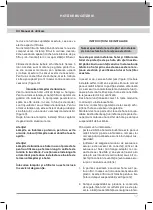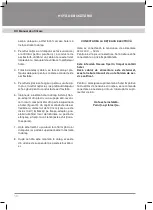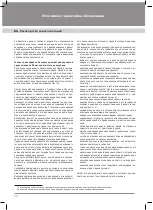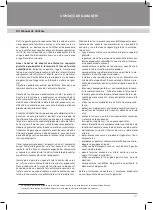
BG
Инструкция за инсталация и употреба
8
EN Application sheet
KITCHEN HOODS
organization where you bought the kitchen
hood or the warranty workshop.
Your model belongs to the class of built-in
kitchen hoods. Different technical and de-
signer variants of mounting such kitchen
hoods in the kitchen cabinet are possible.
Here are the important points:
- the visible part of the kitchen hood is the
lower sliding panel and the lower part of
the case, and the main case of the kitchen
hood is hidden in the cabinet;
- regardless of the choice of air extraction
mode, connect the hood outlet with a flex-
ible air conduit using the reducing flange
and take the air up through the cabinet
(recirculation mode) or connect it to the
air shaft (extraction to the air shaft).
1. There are four holes in the upper part of
the kitchen hood case where plastic plugs
are inserted. These holes are used to fix
the kitchen hood to the cabinet (see Fig.
12).
2. The cabinet is usually made without a bot-
tom, and the middle shelf is located at the
height set in relation to the lower part of
the cabinet so that the hood case would
be sunk into the cabinet.
3. The template inserted along with the in-
structions into the packing tare of the
kitchen hood is used to make a layout on
the middle shelf of the cabinet for screw
holes and a flexible air conduit
4. Use the same template for layout of the
cabinet ceiling to put out the flexible air
conduit.
5. Screw holes are drilled and holes for the
flexible air conduit are made in the middle
shelf.
6. Before the kitchen hood is put into the
cabinet, install a plastic reducing flange
with an antiback valve to the relevant
place above the kitchen hood (Fig. 13). Put
one edge of the flexible air conduit with
the diameter of 120 mm (not included in
the set) on the reducing flange after ap-
plying sealant to the place of junction and
fix it using a clamp (bought separately).
7. The kitchen hood is fixed with the help of
screws to the middle shelf of the cabinet,
and then its upper part is sunk into the
cabinet.
8. After the kitchen hood has been mounted
into the cabinet, the latter is hung to the
kitchen wall.
CONNECTION TO POWER SUPPLY
The kitchen hood is connected to the power
network with the voltage of 220-240V, 50 Hz.
The kitchen hood should be connected to a
wall outlet with earthing to avoid electrocu-
tion.
It is absolutely prohibited to cut off the
plug during kitchen hood installation.
The damaged electrical cord should be
replaced by a qualified service specialist.
For additional protection of the kitchen hood
from voltage drops in the network, connect
it though an additional automatic switch 6A.
The kitchen hood is installed.
Switch it on and use it as you please.









































